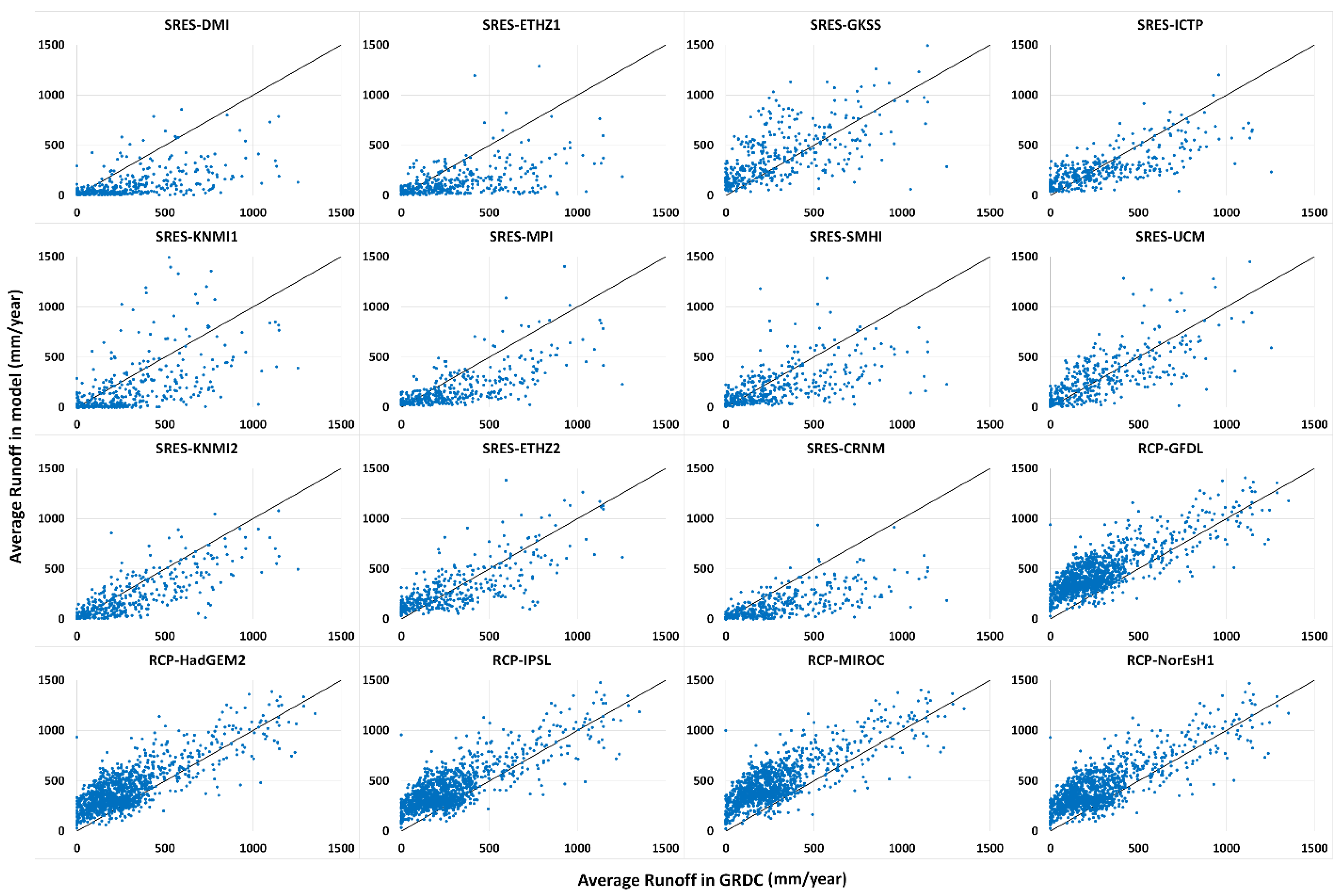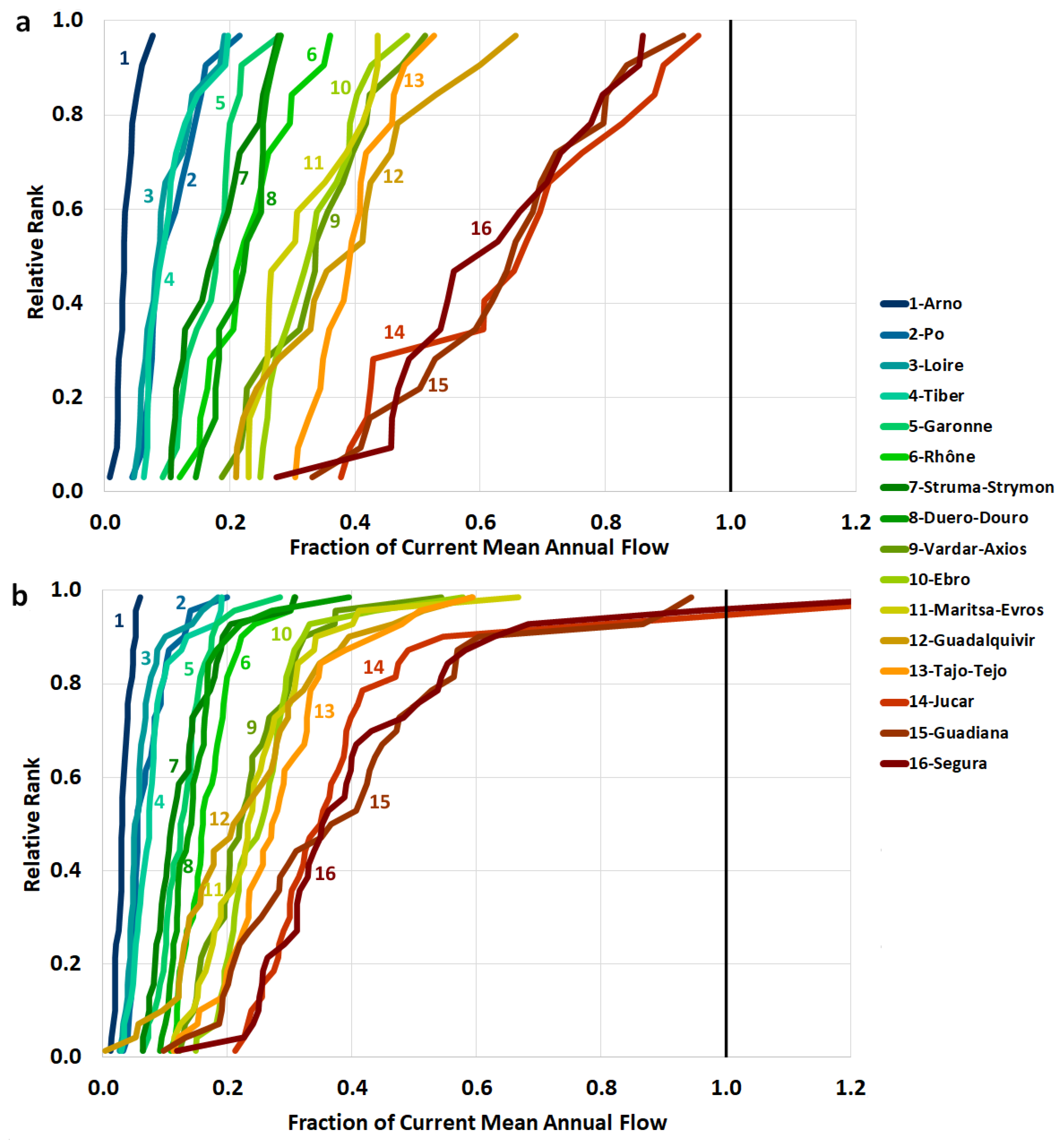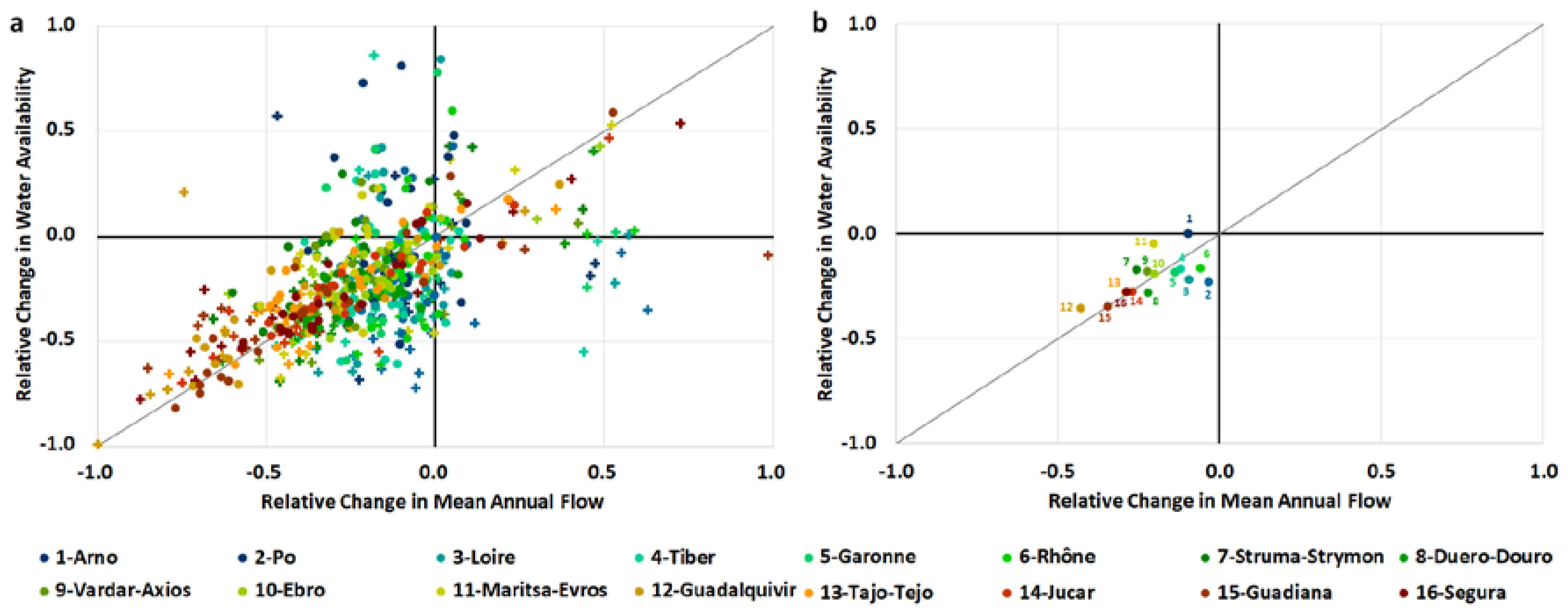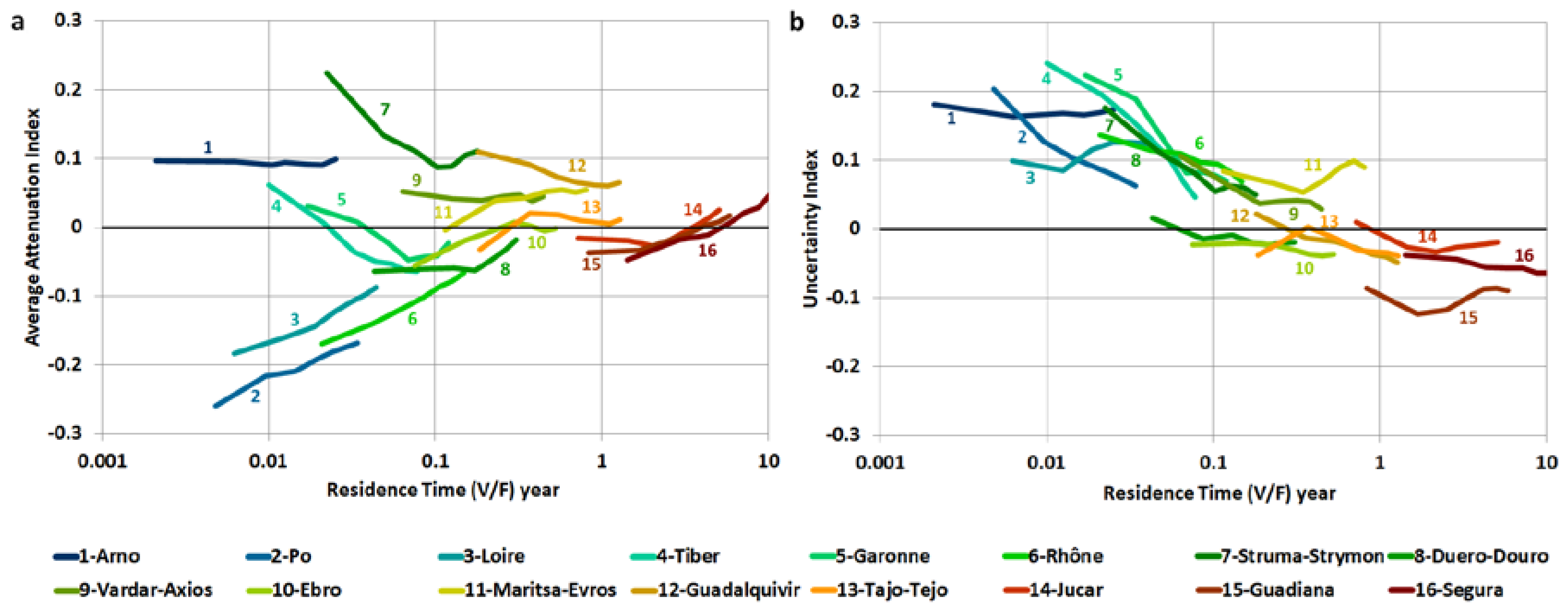Exploring the Role of Reservoir Storage in Enhancing Resilience to Climate Change in Southern Europe
Abstract
1. Introduction
2. Data and Methods
2.1. Area under Analysis
2.2. Methodological Overview
2.3. Current and Future Runoff Scenarios
2.4. Water Availability Analysis
3. Results and Discussion
3.1. Climate Projections
3.2. Water Availability
3.3. The Influence of Storage
4. Conclusions
Supplementary Materials
Author Contributions
Funding
Acknowledgments
Conflicts of Interest
References
- IPCC. Climate change 2014: Impacts, adaptation and vulnerability. Part A: Global and sectoral aspects. In Contribution of Working Group II to the Fifth Assessment Report of the Intergovernmental Panel on Climate Change; Field, C.B., Barros, V.R., Dokken, D.J., Mach, K.J., Mastrandrea, M.D., Bilir, T.E., Chatterjee, M., Ebi, K.L., Estrada, Y.O., Genova, R.C., et al., Eds.; Cambridge University Press: Cambridge, UK; New York, NY, USA, 2014; p. 1132. [Google Scholar]
- Garrote, L. Managing Water Resources to Adapt to Climate Change: Facing Uncertainty and Scarcity in a Changing Context. Water Resour. Manag. 2017, 31, 2951–2963. [Google Scholar] [CrossRef]
- Arnell, N.W. The effect of climate change on hydrological regimes in Europe: A continental perspective. Glob. Environ. Chang. 1999, 9, 5–23. [Google Scholar] [CrossRef]
- Arnell, N.W. Effects of IPCC SRES* emissions scenarios on river runoff: A global perspective. Hydrol. Earth Syst. Sci. 2003, 7, 619–641. [Google Scholar] [CrossRef]
- Vörösmarty, C.J.; McIntyre, P.B.; Gessner, M.O.; Dudgeon, D.; Prusevich, A.; Green, P.; Glidden, S.; Bunn, S.; Sullivan, C.A.; Liermann, C.R.; et al. Global threats to human water security and river biodiversity. Nat. Cell Biol. 2010, 467, 555–561. [Google Scholar] [CrossRef]
- Krysanova, V.; Dickens, C.; Timmerman, J.G.; Varela-Ortega, C.; Schlüter, M.; Roest, K.; Huntjens, P.; Jaspers, F.; Buiteveld, H.; Moreno, E.; et al. Cross-Comparison of Climate Change Adaptation Strategies Across Large River Basins in Europe, Africa and Asia. Water Resour. Manag. 2010, 24, 4121–4160. [Google Scholar] [CrossRef]
- García-Ruiz, J.M.; López-Moreno, J.I.; Vicente-Serrano, S.M.; Lasanta–Martínez, T.; Beguería, S. Mediterranean water resources in a global change scenario. Earth-Sci. Rev. 2011, 105, 121–139. [Google Scholar] [CrossRef]
- Forzieri, G.; Feyen, L.; Rojas, R.G.; Flörke, M.; Wimmer, F.; A Bianchi, A. Ensemble projections of future streamflow droughts in Europe. Hydrol. Earth Syst. Sci. 2014, 18, 85–108. [Google Scholar] [CrossRef]
- Suárez-Almiñana, S.; Solera, A.; Andreu, J.; García-Romero, L. Análisis de incertidumbre de las proyecciones climáticas en relación a las aportaciones históricas en la Cuenca del Júcar. Ing. Agua 2020, 24, 89–99. [Google Scholar] [CrossRef]
- Christensen, J.H.; Carter, T.R.; Rummukainen, M.; Amanatidis, G. Evaluating the performance and utility of regional climate models: The PRUDENCE project. Clim. Chang. 2007, 81, 1–6. [Google Scholar] [CrossRef]
- Hewitt, C.D.; Griggs, D.J. Ensembles-based predictions of climate changes and their impacts. Eos 2004, 85, 566. [Google Scholar] [CrossRef]
- Sordo-Ward, A.; Granados, A.; Iglesias, A.; Garrote, L.; Bejarano, M.D. Adaptation Effort and Performance of Water Management Strategies to Face Climate Change Impacts in Six Representative Basins of Southern Europe. Water 2019, 11, 1078. [Google Scholar] [CrossRef]
- Iglesias, A.; Garrote, L.; Flores, F.; Moneo, M. Challenges to Manage the Risk of Water Scarcity and Climate Change in the Mediterranean. Water Resour. Manag. 2007, 21, 775–788. [Google Scholar] [CrossRef]
- MMA. White Paper on Water in Spain. In Spanish Ministry of the Environment; MMA: Madrid, Spain, 2000. [Google Scholar]
- Berbel, J.; Expósito, A.; Gutiérrez-Martín, C.; Mateos, L. Effects of the Irrigation Modernization in Spain 2002–2015. Water Resour. Manag. 2019, 33, 1835–1849. [Google Scholar] [CrossRef]
- Gil-Meseguer, E.; Bernabé-Crespo, M.B.; Gómez-Espín, J.M. Recycled Sewage—A Water Resource for Dry Regions of Southeastern Spain. Water Resour. Manag. 2019, 33, 725–737. [Google Scholar] [CrossRef]
- Garrote, L.; Granados, A.; Iglesias, A. Assessing water availability in Europe: A comparative study. In Proceedings of the EWRA Conference 2015, Istanbul, Turkey, 10–13 June 2015. [Google Scholar]
- Rippl, W. The Capacity of Storage-Reservoirs for Water-Slpply (Including Plate). Minutes Proc. Inst. Civ. Eng. 2007, 71, 270–278. [Google Scholar] [CrossRef]
- Klemeš, V. One hundred years of applied storage reservoir theory. Water Resour. Manag. 1987, 1, 159–175. [Google Scholar] [CrossRef]
- Löf, G.O.G.; Hardison, C.H. Storage requirements for water in the United States. Water Resour. Res. 2008, 2, 323–354. [Google Scholar] [CrossRef]
- Vogel, R.M.; Lane, M.; Ravindiran, R.S.; Kirshen, P. Storage Reservoir Behavior in the United States. J. Water Resour. Plan. Manag. 1999, 125, 245–254. [Google Scholar] [CrossRef]
- Hashimoto, T.; Stedinger, J.R.; Loucks, D.P. Reliability, resiliency, and vulnerability criteria for water resource system performance evaluation. Water Resour. Res. 1982, 18, 14–20. [Google Scholar] [CrossRef]
- Vogel, R.M.; Bolognese, R.A. Storage-Reliability-Resilience-Yield Relations for Over-Year Water Supply Systems. Water Resour. Res. 1995, 31, 645–654. [Google Scholar] [CrossRef]
- Andreu, J.; Capilla, J.; Sanchís, E. AQUATOOL, a generalized decision-support system for water-resources planning and operational management. J. Hydrol. 1996, 177, 269–291. [Google Scholar] [CrossRef]
- Wurbs, R.A. Assessing Water Availability under a Water Rights Priority System. J. Water Resour. Plan. Manag. 2001, 127, 235–243. [Google Scholar] [CrossRef]
- Yates, D.; Sieber, J.; Purkey, D.; Huber-Lee, A. WEAP21—A Demand-, Priority-, and Preference-Driven Water Planning Model. Water Int. 2005, 30, 487–500. [Google Scholar] [CrossRef]
- McMahon, T.A.; Adeloye, A.J. Water Resources Yield; Water Resources Publications: Highlands Ranch, CO, USA, 2005. [Google Scholar]
- McMahon, T.A.; Adeloye, A.J.; Zhou, S.-L. Understanding performance measures of reservoirs. J. Hydrol. 2006, 324, 359–382. [Google Scholar] [CrossRef]
- Pulido-Velazquez, M.; Andreu, J.; Sahuquillo, A.; Pulido-Velazquez, D. Hydro-economic river basin modelling: The application of a holistic surface–groundwater model to assess opportunity costs of water use in Spain. Ecol. Econ. 2008, 66, 51–65. [Google Scholar] [CrossRef]
- Wurbs, R.A.; Muttiah, R.S.; Felden, F. Incorporation of Climate Change in Water Availability Modeling. J. Hydrol. Eng. 2005, 10, 375–385. [Google Scholar] [CrossRef]
- Garrote, L.; Iglesias, A.; Martín-Carrasco, F.J.; Mediero, L. WAAPA: A model for water availability and climate change adaptation policy analysis. In Proceedings of the EWRA International Symposium—Water Engineering and Management in a Changing Environment, Catania, Italy, 29 June–2 July 2011. [Google Scholar]
- Georgakakos, A.; Yao, H.; Kistenmacher, M.; Graham, N.; Cheng, F.-Y.; Spencer, C.; Shamir, E. Value of adaptive water resources management in Northern California under climatic variability and change: Reservoir management. J. Hydrol. 2012, 412–413, 34–46. [Google Scholar] [CrossRef]
- Alimohammadi, H.; Bavani, A.M.; Roozbahani, A. Mitigating the Impacts of Climate Change on the Performance of Multi-Purpose Reservoirs by Changing the Operation Policy from SOP to MLDR. Water Resour. Manag. 2020, 34, 1495–1516. [Google Scholar] [CrossRef]
- He, S.; Guo, S.; Yang, G.; Chen, K.; Liu, D.; Zhou, Y. Optimizing Operation Rules of Cascade Reservoirs for Adapting Climate Change. Water Resour. Manag. 2019, 34, 101–120. [Google Scholar] [CrossRef]
- Biglarbeigi, P.; Strong, W.A.; Finlay, D.; McDermott, R.; Griffiths, P. A Hybrid Model-Based Adaptive Framework for the Analysis of Climate Change Impact on Reservoir Performance. Water Resour. Manag. 2020, 34, 4053–4066. [Google Scholar] [CrossRef]
- Gorguner, M.; Kavvas, M.L. Modeling impacts of future climate change on reservoir storages and irrigation water demands in a Mediterranean basin. Sci. Total Environ. 2020, 748, 141246. [Google Scholar] [CrossRef] [PubMed]
- EROS. HYDRO1k Elevation Derivative Database. Technical Report. Center for Earth Resources Observation and Science (EROS), U.S. Geological Survey (USGS). 2008. Available online: http://eros.usgs.gov/products/elevation/hydro1k.html-97 (accessed on 27 October 2020).
- Delliou. The History of the World Register of Dams. International Commission on Large Dams. 2020. Available online: https://www.icold-cigb.org/userfiles/files/CIGB/History%20of%20the%20WRD-PleDelliou.pdf (accessed on 27 October 2020).
- González-Zeas, D.; Garrote, L.; Iglesias, A.; Granados, A.; Chavez-Jimenez, A. Hydrologic Determinants of Climate Change Impacts on Regulated Water Resources Systems. Water Resour. Manag. 2015, 29, 1933–1947. [Google Scholar] [CrossRef]
- Garrote, L.; Iglesias, A.; Granados, A.; Mediero, L.; Martín-Carrasco, F. Quantitative Assessment of Climate Change Vulnerability of Irrigation Demands in Mediterranean Europe. Water Resour. Manag. 2014, 29, 325–338. [Google Scholar] [CrossRef]
- Bejarano, M.D.; Granados, I.; Iglesias, A.; Garrote, L. Blue Water in Europe: Estimates of Current and Future Availability and Analysis of Uncertainty. Water 2019, 11, 420. [Google Scholar] [CrossRef]
- Van Beek, L.P.H.; Bierkens, M.F.P. The Global Hydrological Model PCR-GLOBWB: Conceptualization, Parameterization and Verification; Department of Physical Geography, Utrecht University: Utrecht, The Netherlands, 2008; Available online: http://vanbeek.geo.uu.nl/suppinfo/vanbeekbierkens2009.pdf (accessed on 27 October 2020).
- Warszawski, L.; Frieler, K.; Huber, V.; Piontek, F.; Serdeczny, O.; Schewe, J. The Inter-Sectoral Impact Model Intercomparison Project (ISI–MIP): Project framework. Proc. Natl. Acad. Sci. USA 2014, 111, 3228–3232. [Google Scholar] [CrossRef]
- Fekete, B.M.; Vörösmarty, C.J.; Grabs, W. High-resolution fields of global runoff combining observed river discharge and simulated water balances. Glob. Biogeochem. Cycles 2002, 16, 15-1–15-10. [Google Scholar] [CrossRef]
- Tan, Y.; Guzman, S.M.; Dong, Z.; Tan, L. Selection of Effective GCM Bias Correction Methods and Evaluation of Hydrological Response under Future Climate Scenarios. Climate 2020, 8, 108. [Google Scholar] [CrossRef]
- Teutschbein, C.; Seibert, J. Bias correction of regional climate model simulations for hydrological climate-change impact studies: Review and evaluation of different methods. J. Hydrol. 2012, 12–29. [Google Scholar] [CrossRef]
- Sordo-Ward, A.; Bejarano, M.D.; Granados, I.; Garrote, L. Facing Future Water Scarcity in the Duero-Douro Basin: Comparative Effect of Policy Measures on Irrigation Water Availability. J. Water Resour. Plan. Manag. 2020, 146, 04020011. [Google Scholar] [CrossRef]
- Estrela, T.; Marcuello, C.; Dimas, M. Las Aguas Continentales en los Países Mediterráneos de la Unión Europea. CEDEX Report. 2000. Available online: http://hispagua.cedex.es/sites/default/files/aguas_continentales_union_europea.pdf (accessed on 22 December 2020).












| Basin | Basin Area (A) (103 km2) | Mean Annual Flow (F) (km3/year) | Storage Volume (V) (km3) | Specific Runoff (F/A) (mm/year) | Residence Time (V/F) year |
|---|---|---|---|---|---|
| 1-Arno | 10.30 | 4.75 | 0.07 | 462 | 0.01 |
| 2-Po | 84.73 | 47.68 | 0.93 | 563 | 0.02 |
| 3-Loire | 115.91 | 28.82 | 0.72 | 249 | 0.02 |
| 4-Tiber | 17.31 | 7.95 | 0.36 | 459 | 0.04 |
| 5-Garonne | 79.67 | 26.21 | 1.81 | 329 | 0.07 |
| 6-Rhône | 88.43 | 43.79 | 3.72 | 495 | 0.08 |
| 7-Struma-Strymon | 16.81 | 2.24 | 0.23 | 133 | 0.10 |
| 8-Duero-Douro | 96.24 | 19.91 | 3.48 | 207 | 0.17 |
| 9-Vardar-Axios | 22.73 | 4.56 | 1.17 | 201 | 0.26 |
| 10-Ebro | 84.90 | 15.33 | 4.63 | 181 | 0.30 |
| 11-Maritsa-Evros | 52.60 | 7.70 | 3.57 | 146 | 0.46 |
| 12-Guadalquivir | 54.96 | 8.66 | 6.27 | 158 | 0.72 |
| 13-Tajo-Tejo | 69.73 | 11.99 | 8.88 | 172 | 0.74 |
| 14-Júcar | 21.83 | 0.89 | 2.58 | 41 | 2.91 |
| 15-Guadiana | 60.85 | 4.23 | 14.19 | 70 | 3.35 |
| 16-Segura | 17.55 | 0.20 | 1.17 | 11 | 5.83 |
| Basin | ||||||||
|---|---|---|---|---|---|---|---|---|
| Ave | Std | Ave | Std | Ave | Std | Ave | Std | |
| 1-Arno | −0.10 | 0.19 | 0.04 | 0.22 | 0.23 | 0.36 | 0.00 | 0.36 |
| 2-Po | −0.04 | 0.18 | 0.09 | 0.21 | 0.20 | 0.29 | −0.23 | 0.27 |
| 3-Loire | −0.09 | 0.19 | 0.05 | 0.28 | 0.43 | 0.45 | −0.21 | 0.32 |
| 4-Tiber | −0.12 | 0.19 | 0.03 | 0.26 | 0.53 | 0.53 | −0.17 | 0.32 |
| 5-Garonne | −0.14 | 0.19 | 0.02 | 0.26 | 0.46 | 0.43 | −0.18 | 0.27 |
| 6-Rhône | −0.06 | 0.17 | 0.11 | 0.26 | 0.28 | 0.33 | −0.16 | 0.26 |
| 7-Struma-Strymon | −0.26 | 0.20 | −0.13 | 0.22 | 0.93 | 1.00 | −0.17 | 0.26 |
| 8-Duero-Douro | −0.22 | 0.22 | −0.01 | 0.34 | 0.67 | 0.64 | −0.28 | 0.20 |
| 9-Vardar-Axios | −0.23 | 0.19 | −0.06 | 0.22 | 1.01 | 1.06 | −0.18 | 0.23 |
| 10-Ebro | −0.20 | 0.20 | −0.07 | 0.22 | 0.50 | 0.53 | −0.19 | 0.17 |
| 11-Maritsa-Evros | −0.20 | 0.21 | −0.04 | 0.32 | 0.21 | 0.78 | −0.15 | 0.28 |
| 12-Guadalquivir | −0.43 | 0.31 | −0.33 | 0.32 | 0.50 | 0.53 | −0.35 | 0.28 |
| 13-Tajo-Tejo | −0.29 | 0.25 | −0.12 | 0.31 | 0.75 | 0.93 | −0.27 | 0.21 |
| 14-Júcar | −0.27 | 0.27 | −0.11 | 0.38 | 1.38 | 1.63 | −0.27 | 0.24 |
| 15-Guadiana | −0.35 | 0.40 | −0.21 | 0.43 | 1.46 | 1.42 | −0.35 | 0.29 |
| 16-Segura | −0.29 | 0.33 | −0.15 | 0.47 | 0.74 | 1.40 | −0.27 | 0.28 |
Publisher’s Note: MDPI stays neutral with regard to jurisdictional claims in published maps and institutional affiliations. |
© 2021 by the authors. Licensee MDPI, Basel, Switzerland. This article is an open access article distributed under the terms and conditions of the Creative Commons Attribution (CC BY) license (http://creativecommons.org/licenses/by/4.0/).
Share and Cite
Granados, A.; Sordo-Ward, A.; Paredes-Beltrán, B.; Garrote, L. Exploring the Role of Reservoir Storage in Enhancing Resilience to Climate Change in Southern Europe. Water 2021, 13, 85. https://doi.org/10.3390/w13010085
Granados A, Sordo-Ward A, Paredes-Beltrán B, Garrote L. Exploring the Role of Reservoir Storage in Enhancing Resilience to Climate Change in Southern Europe. Water. 2021; 13(1):85. https://doi.org/10.3390/w13010085
Chicago/Turabian StyleGranados, Alfredo, Alvaro Sordo-Ward, Bolívar Paredes-Beltrán, and Luis Garrote. 2021. "Exploring the Role of Reservoir Storage in Enhancing Resilience to Climate Change in Southern Europe" Water 13, no. 1: 85. https://doi.org/10.3390/w13010085
APA StyleGranados, A., Sordo-Ward, A., Paredes-Beltrán, B., & Garrote, L. (2021). Exploring the Role of Reservoir Storage in Enhancing Resilience to Climate Change in Southern Europe. Water, 13(1), 85. https://doi.org/10.3390/w13010085






